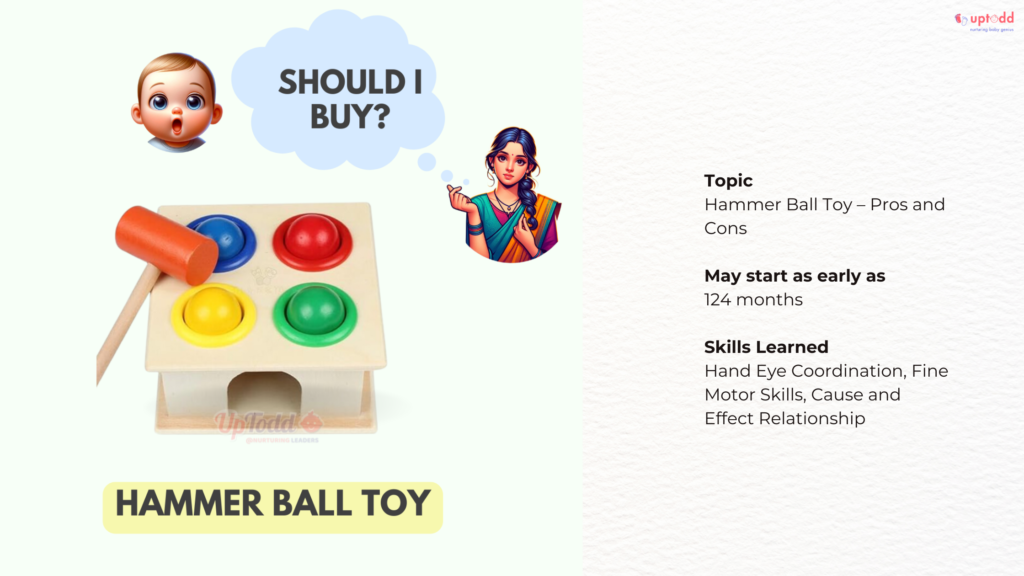
Welcome to our exploration of the Hammer Ball Toy. In this blog post, we’ll take a closer look at this engaging toy, uncovering its benefits and potential drawbacks. Guided by the insights of the “Einstein Growth Guru,” we’ll examine the advantages and drawbacks associated with this engaging toy, aiding you in understanding its role in your child’s playtime.
In this blog, we will cover:
- What are the benefits of this hammer ball toy?
- What are the drawbacks of the hammer ball toy?
- Is this toy the right choice for my baby?

Pros of the Hammer Ball Toy
Now let us know why you and your little one will love the hammer ball toy.
Hand-Eye Coordination
One of the coolest things about this toy is how it helps your little one enhance their hand-eye coordination. As they grip the hammer and aim for those colorful balls, they’re practicing precise movements without even realizing it, strengthening hand muscles and improving dexterity.
Teaches Cause and Effect
With its interactive design, the Hammer Ball Toy teaches children about cause and effect relationships. When your child strikes the ball and it pops out or rolls through a maze, they’re witnessing how their actions have direct consequences. It’s a playful way to introduce them to the basics of science (even if they don’t know it yet), fostering understanding of cause and effect concepts.
Fine Motor Skills Development
We understand that you might think that this toy is just noisy fun, but with this toy your child is actually building fine motor skills. Holding the hammer, positioning the ball, and then making the swing all strengthen hand muscles and improve their dexterity. So, while it might be a bit loud at times, know that those hammer hits are making their little hands more coordinated.
Cons of the Hammer Ball Toy
Yes, this toy has many benefits. But before you buy, here are a few things to consider.
Limited Cognitive Stimulation
Although the Hammer Ball Toy is great for keeping your little one physically engaged, it may not offer as much cognitive stimulation as some other toys. If you’re looking for something that challenges your little one’s problem-solving skills or sparks their creativity, this toy might feel a little repetitive. It’s more about fun and movement than deep thinking.
Aggressive Play
This toy can sometimes bring out a bit of aggression. If your little one really gets into it (and many do!), they might start using the hammer with more force than necessary – especially if they get frustrated or excited. This can pose a risk to siblings, furniture, or even themselves if they aren’t careful. So, it’s best to keep a watchful eye during playtime.
Lack of Creativity or Imagination
Unlike some open ended toys like building blocks or a pretend kitchen, this toy offers a more structured activity. It’s all about hammering, which is fun but doesn’t leave much room for storytelling or imaginative scenarios. It is a little limited in the department of creative play.
Is It Right for Your baby? Here’s the Breakdown
- Recommended Age: Best for toddlers aged 2-5 years.
- Durability: Most are made from sturdy wood or plastic, so they can withstand a few wild hammer swings.
- Safety: Always check that the toy meets safety standards and supervise play, especially for younger toddlers who might not have mastered gentle hammering yet!
Final Thoughts
If you’re looking for a toy that gets your toddler moving, improves their hand-eye coordination, and introduces them to basic concepts like cause and effect, the Hammer Ball Toy is an amazing choice. Every child is different as some will love hammering away for hours, while others might outgrow the toy faster. If your little one is going through an energetic phase or enjoys hands-on, action-based play, this could be just what you need in your toy rotation.
Thanks for joining us on this journey into the world of the Hammer Ball Toy! We hope your little one’s playtime continues to be filled with joy, learning, and lots of fun moments.
Explore UpTodd to unleash hidden abilities of the baby.
Check out this link- https://youtube.com/shorts/UoClXrMWP_s
